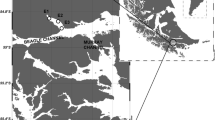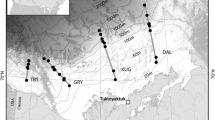Abstract
We studied the fatty acid (FA) content and composition of ten zoobenthic species of several taxonomic groups from different freshwater bodies. Special attention was paid to essential polyunsaturated fatty acids, eicosapentaenoic acid (EPA, 20:5n-3), docosahexaenoic acid (DHA, 22:6n-3), and arachidonic acid (ARA, 20:4n-6); and the n-3/n-6 and DHA/ARA ratios, which are important for consumers of higher trophic levels, i.e., fish. The content and ratios of these FA varied significantly in the studied zoobenthic species, consequently, the invertebrates were of different nutritional quality for fish. Eulimnogammarus viridis (Crustacea) and Dendrocoelopsis sp. (Turbellaria) had the highest nutrition value for fish concerning the content of EPA and DHA and n-3/n-6 and DHA/ARA ratios. Using canonical correspondence analysis we compared the FA profiles of species of the studied taxa taking into account their feeding strategies and habitats. We gained evidence that feeding strategy is of importance to determine fatty acid profiles of zoobenthic species. However, the phylogenetic position of the zoobenthic species is also responsible and may result in a similar fatty acid composition even if species or populations inhabit different water bodies or have different feeding strategies.


Similar content being viewed by others
Abbreviations
- ALA:
-
α-Linolenic acid, 18:3n-3
- ARA:
-
Arachidonic acid, 20:4n-6
- BFA:
-
Branched fatty acids
- DHA:
-
Docosahexaenoic acid, 22:6n-3
- DPA:
-
Docosapentaenoic acid, 22:5n-3
- EPA:
-
Eicosapentaenoic acid, 20:5n-3
- FA:
-
Fatty acid(s)
- FAME:
-
Fatty acid methyl ester(s)
- LNA:
-
Linoleic acid, 18:2n-6
- MUFA:
-
Monounsaturated fatty acid(s)
- NMI:
-
Nonmethylene interrupted
- PUFA:
-
Polyunsaturated fatty acid(s)
- SFA:
-
Saturated fatty acid(s)
References
Desvilettes Ch, Bourdier G, Amblard C, Barth B (1997) Use of fatty acids for the assessment of zooplankton grazing on bacteria, protozoans and microalgae. Freshw Biol 38:629–637
Leveille JC, Amblard C, Bourdier G (1997) Fatty acids as specific algal markers in a natural lacustrian phytoplankton. J Plankton Res 19:469–490
Ederington M, McManus GB, Harvey R (1995) Trophic transfer of fatty acids, sterols, and a triterpenoid alcohol between bacteria, a ciliate, and the copepod Acartia tonsa. Limnol Oceanogr 40:860–867
Gladyshev MI, Sushchik NN, Skoptsova GN, Parfentsova LS, Kalachova GS (1999) Use of biochemical markers provides evidence of selective feeding in zoobenthic omnivorous organisms of a fish-rearing pond. Doklady Biol Sci 364:67–69
Gladyshev MI, Emelianova AY, Kalachova GS, Zotina TA, Gaevsky NA, Zhilenkov MD (2000) Gut content analysis of Gammarus lacustris from Siberian lake using biochemical and biophysical methods. Hydrobiologia 431:155–163
Brett MT, Muller-Navarra DC (1997) The role of highly unsaturated fatty acids in aquatic foodweb processes. Freshw Biol 38:483–499
Muller-Navarra DC, Brett MT, Liston AM, Goldman CR (2000) A highly unsaturated fatty acid predicts carbon transfer between primary producers and consumers. Nature 403:74–77
Arts MT, Ackman RG, Holub BJ (2001) ‘Essential fatty acids’ in aquatic ecosystems: a crucial link between diet and human health and evolution. Can J Fish Aquat Sci 58:122–137
Lauritzen L, Hansen HS, Jorgensen MH, Michaelsen KF (2001) The essentiality of long chain n-3 fatty acids in relation to development and function of the brain and retina. Prog Lipid Res 40:1–94
Broadhurst CL, Wang Y, Crawford MA, Cunnane SC, Parkington JE, Schmidt WF (2002) Brain-specific lipids from marine, lacustrine, or terrestrial food resources: potential impact on early African Homo sapiens. Comp Biochem Physiol B 131:653–673
Ahlgren G, Vrede T, Goedkoop W (2009) Fatty acid ratios in freshwater fish, zooplankton and zoobenthos—are there specific optima? In: Arts MT, Brett MT, Kainz MJ (ed) Lipids in aquatic ecosystems, Springer, Dordrecht
Lim C, Ako H, Brown CL, Hahn K (1997) Growth response and fatty acid composition of juvenile Penaeus uannamei fed different sources of dietary lipid. Aquaculture 151:143–153
Deerign MJ, Fielder DR, Hewitt DR (1997) Growth and fatty acid composition of juvenile leader prawns, Penaeus monodon, fed different lipids. Aquaculture 151:131–141
Milke LM, Bricelj VM, Parrish CC (2004) Growth of postlarval sea scallops, Placopecten magellanicus, on microalgal diets, with emphasis on the nutritional role of lipids and fatty acids. Aquaculture 234:293–317
Özyurt G, Duysak Ö, Akamca E, Tureli C (2006) Seasonal changes of fatty acids of cuttlefish Sepia officinalis L. (Mollusca: Cephalopoda) in the north eastern Mediterranean sea. Food Chem 95:382–385
Sinanoglou VJ, Meimaroglou D, Miniadis-Meimaroglou S (2008) Triacylglycerols and their fatty acid composition in edible Mediterranean molluscs and crustacean. Food Chem 110:406–413
Napolitano GE (1998) Fatty acids as trophic and chemical markers in freshwater ecosystems. In: Arts MT, Wainman BC (eds) Lipids in freshwater ecosystems. Springer, New York
Brett MT, Muller-Navarra DC, Ballantyne AP, Ravet JL, Goldman CR (2006) Daphnia fatty acid composition reflects that of their diet. Limnol Oceanogr 51:2428–2437
Muller-Navarra DC (2006) The nutritional importance of polyunsaturated fatty acids and their use as trophic markers for herbivorous zooplankton: does it contradict? Arch Hydrobiol 164:501–513
Weers PMM, Siewertsen K, Gulati RD (1997) Is the fatty acid composition of Daphnia galeata determined by the fatty acid composition of the ingested diet? Freshw Biol 48:731–738
Von Elert E (2002) Determination of limiting polyunsaturated fatty acids in Daphnia galeata using a new method to enrich food algae with single fatty acids. Limnol Oceanogr 47:1764–1773
Gladyshev MI, Sushchik NN, Makhutova ON, Dubovskaya OP, Kravchuk ES, Kalachova GS, Khromechek EB (2010) Correlations between fatty acid composition of seston and zooplankton and effects of environmental parameters in a eutrophic Siberian reservoir. Limnologica 40:343–357
Graeve M, Albers C, Kattner G (2005) Assimilation and biosynthesis of lipids in arctic Calanus species based on feeding experiments with a 13C labelled diatom. J Exp Mar Biol Ecol 317:109–125
Veloza AJ, Chu F-LE, Tang KW (2006) Trophic modification of essential fatty acids by heterotrophic protists and its effects on the fatty acid composition of the copepod Acartia tonsa. Mar Biol 148:779–788
Smyntek PM, Teece MA, Schulz KL, Storch AJ (2008) Taxonomic differences in the essential fatty acid composition of groups of freshwater zooplankton relate to reproductive demands and generation time. Freshw Biol 53:1768–1782
Ravet JL, Brett MT, Arhonditsis GB (2010) The effects of seston lipids on zooplankton fatty acid composition in Lake Washington, Washington, USA. Ecology 91:180–190
Wallis JG, Watts JL, Browse J (2002) Polyunsaturated fatty acid synthesis: what will they think of next? Trends Biochem Sci 27:467–473
Goedkoop W, Demandt M, Ahlgren G (2007) Interactions between food quantity and quality (long-chain polyunsaturated fatty acids concentrations) effects on growth and development of Chironomus riparius. Can J Fish Aquat Sci 64:425–436
Sushchik NN, Gladyshev MI, Moskvicheva AV, Makhutova ON, Kalachova GS (2003) Comparison of fatty acid composition in major lipid classes of the dominant benthic invertebrates of the Yenisei river. Comp Biochem Physiol B 134:111–122
Bell JG, Ghioni C, Sargent JR (1994) Fatty acid composition of 10 freshwater invertebrates which are natural food organisms of Atlantic salmon parr (Salmo salar); a comparison with commercial diet. Aquaculture 128:301–313
Torres-Ruiz M, Wehr JD, Perrone AA (2010) Are net-spinning caddisflies what they eat? An investigation using controlled diets and fatty acids. J N Am Benthol Soc 29:803–813
Maazouzi C, Masson G, Izquierdo MS, Pihan J-C (2007) Fatty acid composition of the amphipod Dikerogammarus villosus: Feeding strategies and trophic links. Comp Biochem Physiol A 147:868–875
Kraffe E, Grall J, Le Duff M, Soudant P, Marty Y (2008) A striking parallel between cardiolipin fatty acid composition and phylogenetic belonging in marine bivalves: a possible adaptative evolution? Lipids 43:961–970
Makhutova ON, Sushchik NN, Kalachova GS, Ageev AV (2009) Fatty acid content and composition of freshwater planaria Dendrocoelopsis sp. (Planariidae, Turbellaria, Platyhelminthes) from the Yenisei River. J Sib Fed Univ Biol 2:135–144
Christie WW (1989) Gas Chromatography and Lipids. A Practical Guide. The Oily Press, England
Campbell RC (1967) Statistics for Biologists, University Press, Cambridge
Halanych KM (2004) The new view of animal phylogeny. Annu Rev Ecol Evol Syst 35:229–256
Arts MT, Kohler CC (2009) Health and condition in fish: the influence of lipids on membrane competency and immune response. In: Arts MT, Brett MT, Kainz MJ (eds) Lipids in aquatic ecosystems, Springer, Dordrecht
Sushchik NN, Gladyshev MI, Kalachova GS, Makhutova ON, Ageev AV (2006) Comparison of seasonal dynamics of the essential PUFA contents in benthic invertebrates and grayling Thymallus arcticus in the Yenisei river. Comp Biochem Physiol B 145:278–287
Goedkoop W, Sonesten L, Ahlgren G, Boberg M (2000) Fatty acids in profundal benthic invertebrates and their major food resources in Lake Erken, Sweden: seasonal variation and trophic indications. Can J Fish Aquat Sci 57:2267–2279
Sushchik NN, Gladyshev MI, Kravchuk ES, Ivanova EA, Ageev AV, Kalachova GS (2007) Seasonal dynamics of long-chain polyunsaturated fatty acids in littoral benthos in the upper Yenisei River. Aquat Ecol 41:349–365
Torres-Ruiz M, Wehr JD, Perrone AA (2007) Trophic relations in a stream food web: importance of fatty acids for macroinvertebrate consumers. J N Am Benthol Soc 26:509–522
Biandolino F, Prato E (2006) A preliminary investigation of the lipids and fatty acids composition of Gammarus aequicauda (Crustacea: Amphipoda) and its main food source. J Mar Biol Ass 86:345–348
Kolanowski W, Stolyhwo A, Grabowski M (2007) Fatty acid composition of selected fresh water gammarids (Amphipoda, Crustacea): a potentially innovative source of omega-3 LC PUFA. J Am Oil Chem Soc 84:827–833
Schlechtriem Ch, Arts MT, Johannsson OE (2008) Effect of long-term fasting on the use of fatty acids as trophic markers in the opossum shrimp Mysis relicta—a laboratory study. J Great Lakes Res 34:143–152
Canuel EA, Cloern JE, Ringelberg DB, Guckert JB, Rau GH (1995) Molecular and isotopic tracers used to examine sources of organic matter and its incorporation into the food webs of San Francisco Bay. Limnol Oceanogr 40:67–81
Murphy KJ, Mooney BD, Mann NJ, Nichols PD, Sinclair AJ (2002) Lipid, FA, and sterol composition of New Zealand green lipped mussel (Perna canaliculus) and Tasmanian blue mussel (Mytilus edulis). Lipids 37:587–595
Berge J-P, Barnathan G (2005) Fatty acids from lipids of marine organisms: molecular biodiversity, roles as biomarkers, biologically active compounds, and economical aspects. Adv Biochem Eng Biotechnol 96:49–125
Pernet F, Tremblay R, Comeau L, Guderley H (2007) Temperature adaptation in two bivalve species from different thermal habitats: energetics and remodelling of membrane lipids. J Exp Biol 210:2999–3014
Fried B, Rao KS, Sherma J, Huffman JE (1993) Fatty acid composition of Goniobasis virginica, Physa sp. and Viviparus malleatus (Mollusca: Gastropoda) from lake Musconetcong, New Jersey. Biochem Syst Ecol 21:809–812
Zhukova N (2007) Lipid classes and fatty acid composition of the tropical Nudibranch mollusks Chromodoris sp. and Phyllidia coelestis. Lipids 42:1169–1175
Politi LE, De Santos SV, De Linares LV (1992) Phospholipids and fatty acids in intact and regenerating Dugesia anceps, a fresh water planaria. Zool Sci 9:671–674
Cripps GC, Atkinson A (2000) Fatty acid composition as an indicator of carnivory in Antarctic krill, Euphausia superba. Can J Fish Aquat Sci 57:31–37
Falk-Petersen S, Hagen W, Kattner G, Clarke A, Sargent J (2000) Lipids, trophic relationships, and biodiversity in Arctic and Antarctic krill. Can J Fish Aquat Sci 57:178–191
Stevens CJ, Deibel D, Parrish CC (2004) Species-specific differences in lipid composition and omnivory indices in Arctic copepods collected in deep water during autumn (North Water Polynya). Mar Biol 144:905–915
Cazzaniga NJ, Tamburi N, Carrizo M, Ponce GF (2002) Feeding Girardia anceps (Platyhelminthes: Tricladida) in the laboratory. J Freshw Ecol 17:93–98
Tranchida MC, Macia A, Brusa F, Micieli MV, Garcia JJ (2009) Predation potential of three flatworm species (Platyhelminthes: Turbellaria) on mosquitoes (Diptera: Culicidae). Biol Control 49:270–276
Acknowledgments
The work was supported by grants from the Russian Foundation for Basic Research (RFBR) No. 09-04-01085 and No. 08-05-00095, by “Thematic plan programs” from the Ministry of Education and Sciences of Russian Federation (Theme B-4 of Siberian Federal University).
Author information
Authors and Affiliations
Corresponding author
About this article
Cite this article
Makhutova, O.N., Sushchik, N.N., Gladyshev, M.I. et al. Is the Fatty Acid Composition of Freshwater Zoobenthic Invertebrates Controlled by Phylogenetic or Trophic Factors?. Lipids 46, 709–721 (2011). https://doi.org/10.1007/s11745-011-3566-9
Received:
Accepted:
Published:
Issue Date:
DOI: https://doi.org/10.1007/s11745-011-3566-9




